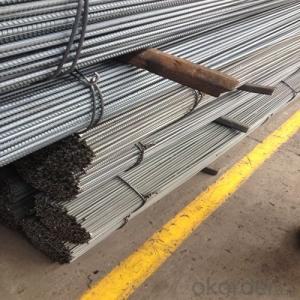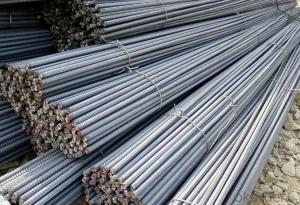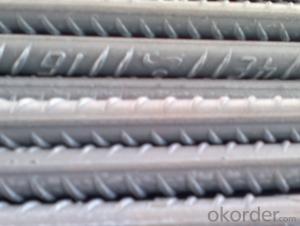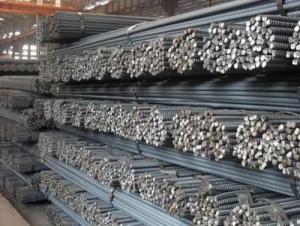Hot Rolled Steel Rebar Deformed Bar High Quality
- Loading Port:
- Tianjin
- Payment Terms:
- TT OR LC
- Min Order Qty:
- 1000 m.t.
- Supply Capability:
- 30000 m.t./month
OKorder Service Pledge
OKorder Financial Service
You Might Also Like
Product Description:
Quick Details
Standard:AISI, ASTM, BS, DIN, GB, JIS
Grade:HRB335
Diameter:10mm-40mm
Length:Normally 6~12m
Place of Origin:Fujian, China (Mainland)
Model Number:QZMM-ST001
Application:Building material, construction, road, bridge,etc
Product Name:Steel Rebars,Deformed Steel Bars,Building Material China Manufacturer
Standard:ASTM A615 /BS BS 4449 /GB HRB/ JIS G3112
Material:HRB335
Shape:Straight reinforcing bars
Technique:Low temperature hot-rolling reinforcing deformed steel rebar
Tolerance:As the standard or as your requirement
MOQ:100tons per size steel rebar
Packing details Steel:Steel rebar packed in bundle or as your requirement
Delivery:Within 30 days after deposit
Post:XIAMEN,CHINA
Packaging & Delivery
| Packaging Details: | in bundles or as customer's requirement |
|---|---|
| Delivery Detail: | Within 30days after receiving your deposit or copy of L/C |
Product Description
| Name | Steel Rebars,Deformed Steel Bars,Building Material China Manufacturer |
| Standard | ASTM A615 /BS BS 4449 /GB HRB/ JIS G3112 |
| Grade | A615 Gr40/60/75 BS 4449 Gr460,B500 GB HRB335(E) JIS G3112 SD390 |
| Diameter | 10mm-40mm |
| Length | 6-12m |
| Technique | Low temperature hot-rolling reinforcing deformed steel rebar |
| Tolerance | As the standard or as your requirement |
| Application | Building, construction, road, bridge,etc |
| Certificated | BV |
| MOQ | 100tons per size steel rebar |
| Packing details | Steel rebar packed in bundle or as your requirement |
| Delivery | Within 30 days after deposit |
| Payment | T/T or L/C |
Chemical Composition
Grade | Technical data of the original chemical composition (%) | |||||||
C | Mn | Si | S | P | B | |||
HRB335 | ≤0.25 | ≤1.60 | ≤0.80 | ≤0.045 | ≤0.045 | >0.0008 | ||
Physics capability | ||||||||
Yield Strength(N/cm2) | Tensile Strength(N/cm2) | Elongation (%) | ||||||
≥335 | ≥490 | ≥16 | ||||||
Grade | Technical data of the original chemical composition (%) | |||||||
C | Mn | Si | S | P | V | |||
HRB400 | ≤0.25 | ≤1.60 | ≤0.80 | ≤0.045 | ≤0.045 | 0.04-0.12 | ||
Physics capability | ||||||||
Yield Strength(N/cm2) | Tensile Strength(N/cm2) | Elongation (%) | ||||||
≥400 | ≥570 | ≥14 | ||||||
Usage and Applications of HRB400 Deformed Steel Bar:
Deformed bar is widely used in buildings, bridges, roads and other engineering construction. Big to highways, railways, bridges, culverts, tunnels, public facilities such as flood control, dam, small to housing construction, beam, column, wall and the foundation of the plate, deformed bar is an integral structure material. With the development of world economy and the vigorous development of infrastructure construction, real estate, the demand for deformed bar will be larger and larger..
Packaging & Delivery of HRB400 Deformed Steel Bar:
Packaging Detail: products are packed in bundle and then shipped by container or bulk vessel, deformed bar is usually naked strapping delivery, when storing, please pay attention to moisture proof. The performance of rust will produce adverse effect.
Each bundle weight: 2-3MT, or as required
Payment term: TT or L/C
Delivery Detail: within 45 days after received advanced payment or LC.
Label: to be specified by customer, generally, each bundle has 1-2 labels
Trade terms: FOB, CFR, CIF
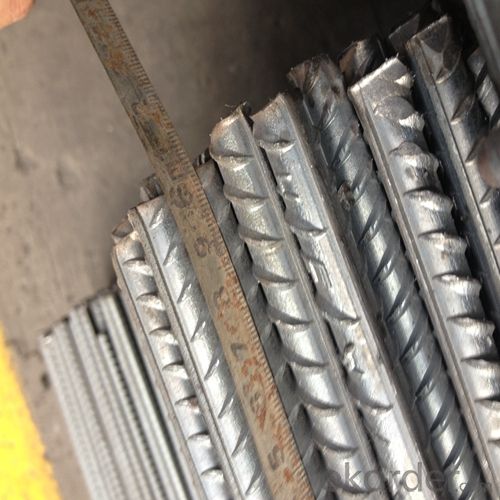
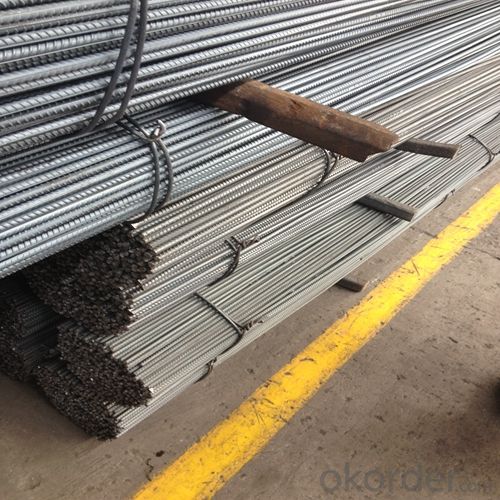
- Q:How can the quality of steel rebars be tested?
- The quality of steel rebars can be tested through various methods such as visual inspection, dimensional measurement, destructive testing (such as tensile strength and elongation tests), non-destructive testing (such as ultrasonic testing, magnetic particle inspection, and radiographic testing), chemical analysis, and corrosion resistance evaluation. These methods collectively ensure that the steel rebars meet the required quality standards and are free from defects or weaknesses.
- Q:How do steel rebars contribute to the overall ductility of a structure?
- Steel rebars contribute to the overall ductility of a structure by providing reinforcement and enhancing its ability to withstand deformations and absorb energy without failure. The addition of rebars in concrete structures improves its tensile strength, as concrete alone is weak in tension. This combination allows the structure to flex and bend under loading, reducing the risk of brittle failure and increasing its overall resilience.
- Q:How are steel rebars used in swimming pool construction?
- Steel rebars are used in swimming pool construction to reinforce the concrete structure of the pool. The rebars are strategically placed within the concrete to provide additional strength and prevent cracking or structural damage over time. This reinforcement helps the pool withstand the pressure of the water and any external forces, ensuring its long-term durability and stability.
- Q:What's the difference between rebar and thread steel?
- A ribbed steel bar with 2 longitudinal ribs and uniformly distributed ribs along the length. This is thread steel. It belongs to the category of reinforcement.
- Q:How do steel rebars contribute to the ductility of reinforced concrete structures?
- The ductility of reinforced concrete structures is enhanced by steel rebars which serve multiple purposes. Firstly, by resisting tensile forces, the rebars prevent the concrete from cracking or failing under tension. This allows the structure to deform and absorb energy without catastrophic failure. Secondly, the rebars distribute applied loads across a wider area, reducing localized concentrations and promoting flexibility and energy absorption. Additionally, the rebars provide anchorage and confinement to the concrete, preventing slippage and expansion under tension. In conclusion, steel rebars contribute to the overall ductility of reinforced concrete structures by providing tensile strength, stress redistribution, and anchorage and confinement capabilities.
- Q:What is the weight of a standard steel rebar?
- The weight of a standard steel rebar can vary depending on its length and diameter. On average, a 1-meter long steel rebar with a diameter of 12 millimeters weighs around 0.89 kilograms.
- Q:What is the average lifespan of steel rebars in marine environments?
- The average lifespan of steel rebars in marine environments varies depending on several factors such as the quality of the steel, level of exposure to saltwater and other corrosive elements, maintenance practices, and design considerations. However, with proper corrosion protection measures and regular maintenance, steel rebars in marine environments can typically last around 30 to 50 years.
- Q:How do steel rebars affect the constructability of complex architectural designs?
- Steel rebars play a crucial role in the constructability of complex architectural designs. These reinforced bars provide structural integrity and strength to concrete elements, making it possible to create intricate and innovative designs. Firstly, steel rebars allow architects to design structures with larger spans and heights, as they provide the necessary load-bearing capacity. This is particularly important in complex designs that involve cantilevers, soaring roofs, or suspended floors, as the rebars distribute the loads evenly and prevent structural failure. Moreover, steel rebars enhance the constructability of complex architectural designs by enabling the creation of slender and lightweight structures. Since rebars are strong and durable, they can be used to reinforce thin concrete elements, reducing the overall weight of the structure. This not only enhances the aesthetic appeal of the design but also minimizes the amount of material required, resulting in cost savings during construction. In addition, steel rebars offer flexibility during the construction process. They can be easily bent and shaped to match the intricate geometries and curves of complex architectural designs. This allows architects to realize their creative vision by incorporating unique and eye-catching elements into the structure. Furthermore, steel rebars contribute to the durability and longevity of complex architectural designs. By reinforcing the concrete, they increase its resistance to cracking, bending, and corrosion. This is especially important in areas prone to seismic activity or harsh weather conditions. The use of rebars ensures that the structure can withstand these challenges and remain intact over time. Overall, steel rebars significantly impact the constructability of complex architectural designs. Their strength, versatility, and ability to reinforce concrete elements make it possible to create innovative structures that are both visually appealing and structurally sound. Without the support of steel rebars, the construction of such complex designs would be much more challenging, if not impossible.
- Q:How are steel rebars classified based on grades?
- The strength of steel rebars is determined by their grade, which is based on their minimum yield strength. Steel rebars are classified into different grades to indicate their ability to withstand stress and loads. Grade 40, Grade 60, and Grade 75 are the most commonly used grades for steel rebars. Grade 40 rebars have a minimum yield strength of 40,000 psi and are typically used in general construction projects where high strength is not the main requirement. They are suitable for light to moderate load-bearing structures such as residential buildings, sidewalks, and driveways. Grade 60 rebars, with a minimum yield strength of 60,000 psi, are the most widely used for construction purposes. They can be applied in a wide range of applications and are commonly used in reinforced concrete structures, bridges, highways, and commercial buildings. Grade 60 rebars provide the necessary strength to withstand heavy loads and seismic forces. Grade 75 rebars, with a minimum yield strength of 75,000 psi, are designed for high-stress applications. They are mainly used in large-scale infrastructure projects, including high-rise buildings, dams, and heavy industrial structures. Grade 75 rebars offer exceptional strength and durability, making them suitable for projects that require superior load-bearing capacity and resistance to extreme conditions. It is important to note that the specific requirements and standards for steel rebars may vary among different countries and regions. Therefore, it is crucial to adhere to local codes and regulations to determine the appropriate grade of steel rebar for each construction project.
- Q:Why is the earthing device forbidden to use thread steel instead of round steel as lap steel bar?
- H, R, and B are the first letters in English for hot-rolled (Hotrolled), ribbed (Ribbed) and reinforced (Bars) three words. Hot rolled ribbed bar is divided into two levels, HRB335 (old No. 20MnSi), three HRB400 (20MnSiV, 20MnSiNb, old No. 20Mnti), four grade HRB500 three grade.
1. Manufacturer Overview |
|
|---|---|
| Location | |
| Year Established | |
| Annual Output Value | |
| Main Markets | |
| Company Certifications | |
2. Manufacturer Certificates |
|
|---|---|
| a) Certification Name | |
| Range | |
| Reference | |
| Validity Period | |
3. Manufacturer Capability |
|
|---|---|
| a)Trade Capacity | |
| Nearest Port | |
| Export Percentage | |
| No.of Employees in Trade Department | |
| Language Spoken: | |
| b)Factory Information | |
| Factory Size: | |
| No. of Production Lines | |
| Contract Manufacturing | |
| Product Price Range | |
Send your message to us
Hot Rolled Steel Rebar Deformed Bar High Quality
- Loading Port:
- Tianjin
- Payment Terms:
- TT OR LC
- Min Order Qty:
- 1000 m.t.
- Supply Capability:
- 30000 m.t./month
OKorder Service Pledge
OKorder Financial Service
Similar products
New products
Hot products
Hot Searches
Related keywords
